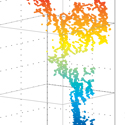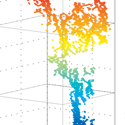Gravity organizes sediment
Self-organized criticality (SOC), proposed by Per Bak, Chao Tang, and Kurt Wiesenfeld, is a property of dynamical systems that leads to scale-invariant behavior without the need to fine tune parameters to precise values as required in an ordinary phase transition. The ideas have been applied to study diverse phenomena ranging from the power-law distribution of earthquake intensities to forest fires and even biological evolution. SOC has inspired countless numerical and theoretical studies, but the few experimental characterizations such as liquid near the superfluid transition, or rice piles, do not elucidate how criticality arises far from equilibrium.
In a recent work to appear in Physical Review Letters, Laurent Corté and collaborators from Mines-ParisTech, France, and New York University, Cornell University, and San Francisco State University, all in the US, report self-organized criticality in suspensions of sedimenting particles undergoing periodic shear. The new experiment builds on an earlier observation of a continuous phase transition between an absorbing state (at small shear rates and/or low concentrations) where particles return to their original positions after each shear cycle and an active state (in the opposite limit) where particle positions change randomly. Corté et al. use particles slightly denser than the surrounding fluid; in the absence of shear, a dense sediment forms at the bottom. Applying shear, the suspension is attracted to its critical state since, when the concentration is less than critical, particles are inactive and sediment, increasing the concentration, whereas for concentrations above critical, activity tends to spread the particles over a larger range of heights, reducing the density. This observation of SOC opens a new route to explore properties of out-of-equilibrium critical phenomena. – Ronald Dickman





